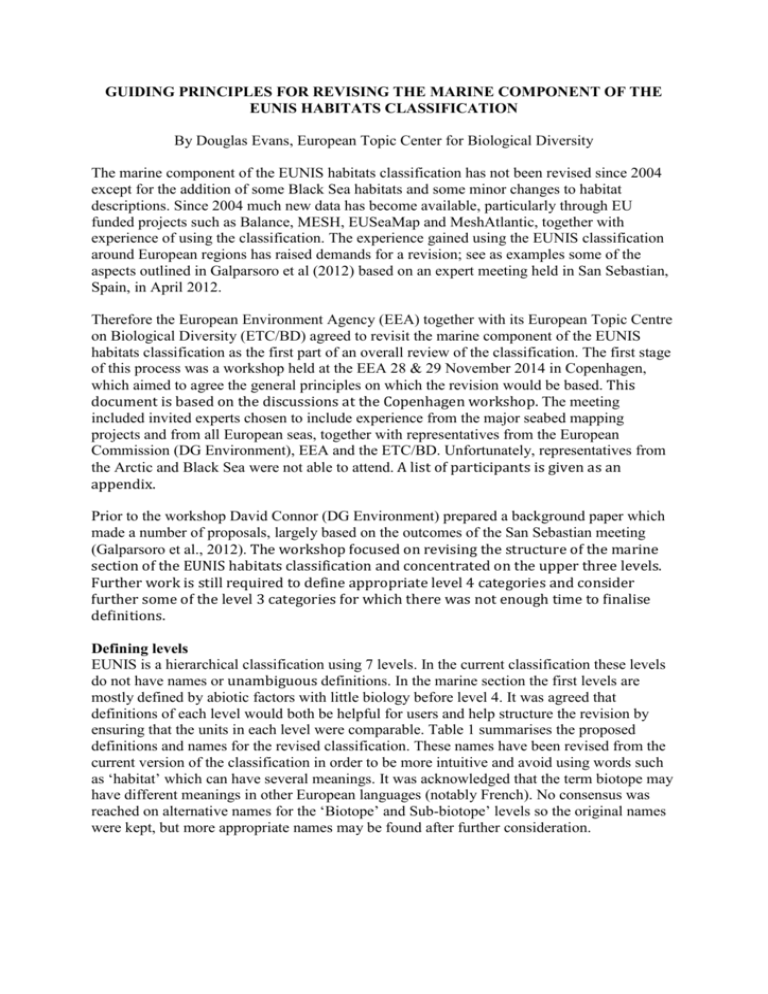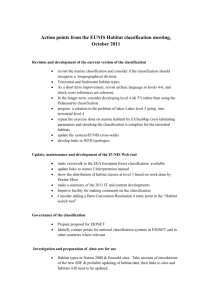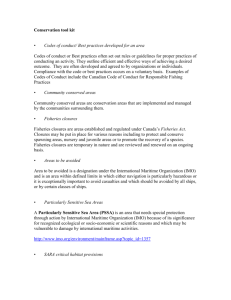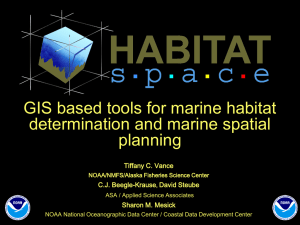GUIDING PRINCIPLES FOR REVISING THE MARINE COMPONENT OF THE EUNIS
advertisement

GUIDING PRINCIPLES FOR REVISING THE MARINE COMPONENT OF THE EUNIS HABITATS CLASSIFICATION By Douglas Evans, European Topic Center for Biological Diversity The marine component of the EUNIS habitats classification has not been revised since 2004 except for the addition of some Black Sea habitats and some minor changes to habitat descriptions. Since 2004 much new data has become available, particularly through EU funded projects such as Balance, MESH, EUSeaMap and MeshAtlantic, together with experience of using the classification. The experience gained using the EUNIS classification around European regions has raised demands for a revision; see as examples some of the aspects outlined in Galparsoro et al (2012) based on an expert meeting held in San Sebastian, Spain, in April 2012. Therefore the European Environment Agency (EEA) together with its European Topic Centre on Biological Diversity (ETC/BD) agreed to revisit the marine component of the EUNIS habitats classification as the first part of an overall review of the classification. The first stage of this process was a workshop held at the EEA 28 & 29 November 2014 in Copenhagen, which aimed to agree the general principles on which the revision would be based. This document is based on the discussions at the Copenhagen workshop. The meeting included invited experts chosen to include experience from the major seabed mapping projects and from all European seas, together with representatives from the European Commission (DG Environment), EEA and the ETC/BD. Unfortunately, representatives from the Arctic and Black Sea were not able to attend. A list of participants is given as an appendix. Prior to the workshop David Connor (DG Environment) prepared a background paper which made a number of proposals, largely based on the outcomes of the San Sebastian meeting (Galparsoro et al., 2012). The workshop focused on revising the structure of the marine section of the EUNIS habitats classification and concentrated on the upper three levels. Further work is still required to define appropriate level 4 categories and consider further some of the level 3 categories for which there was not enough time to finalise definitions. Defining levels EUNIS is a hierarchical classification using 7 levels. In the current classification these levels do not have names or unambiguous definitions. In the marine section the first levels are mostly defined by abiotic factors with little biology before level 4. It was agreed that definitions of each level would both be helpful for users and help structure the revision by ensuring that the units in each level were comparable. Table 1 summarises the proposed definitions and names for the revised classification. These names have been revised from the current version of the classification in order to be more intuitive and avoid using words such as ‘habitat’ which can have several meanings. It was acknowledged that the term biotope may have different meanings in other European languages (notably French). No consensus was reached on alternative names for the ‘Biotope’ and Sub-biotope’ levels so the original names were kept, but more appropriate names may be found after further consideration. Table 1: Proposed definitions for the revised marine component of the EUNIS habitats classification. Level Name Level 1 Realm Level 2 Level 3 Definition Contains a single class: Marine. Equivalent This is equivalent to the Terrestrial and Freshwater realms. Biological zone and substrate Bioregion Level 4 Functional habitat Level 5 Biotope Level 6 Subbiotope Level 7 Each major substrate class is coupled with each major zone. Regions characterised by temperature and salinity. Finer divisions of substrate, zone, bioregion, salinity, energy or other physical factor used and/or main biological ‘life-form’ (e.g. kelp forest, mussel beds). Habitat defined by a dominant or characteristic species or by consistent multi-species characteristics or by an assemblage (community or biocenosis) and by distinctive habitat features, which together, allow distinction from neighbouring types. Habitat defined by more subtle variation in species composition, coupled with associated physical differences Due to proposed restructuring, this level is not needed Zonation and substrate (level 2) The first major division in the marine part of the EUNIS classification is based on major biological zones (related to depth) and substrate type. The definitions of zones vary between sea regions. Table 2 shows the agreed zones and substrate classes. Table 2: Zones and substrate classes to be used for the marine component of the revised EUNIS habitats classification. Zone Hard Rock Other Coarse Mixed Soft Sand Mud Other Littoral Infralittoral Circalittoral Aphotic* Bathyal Abyssal * Aphotic as shown is a simplification and there can be photic communities in the upper Circalittoral, for example in the Atlantic there can be a narrow zone of sparse erect algae. Photic Notes Within the classification, the bathyal zone is considered to be the continental slope whilst the abyssal zone starts at the base of the slope and is the plain. The circalittoral and bathyal zones were not sub-divided into upper and lower sub-zones at level 2 as no consistent and ambiguous definition for these sub-zones could be established for all European seas. It was agreed to retain the four main sediment classes as there was insufficient evidence to change these or their boundaries at present. Within the substrate classes, for hard seabed ‘Other’ is primarily biogenic reefs that create a hard compact substrata (regardless of the underlying substrate) but may also include other types of ‘concretions’ (e.g. HELCOM units for mettalliferous nodules or methane-derived authigenic carbonates associated with methane seeps). For sedimentary seabed, ‘Other’ refers to habitats where the vegetation covers or transforms the underlying substrate, e.g. Posidonia beds where the Posidonia effectively becomes the substrate (to the extent that the ‘original’ substrate cannot be identified) and saltmarsh habitats. It was acknowledged that these two ‘Other’ categories would need to be associated with clear identification criteria/thresholds and may need to accommodate some other types which cannot readily be assigned to the main substrate types. Biogeographical regions (level 3) It was agreed that level 3 should reflect the main biogeographical regions of Europe’s seas based on their distinct combinations of salinity and temperature regimes. The following regions were agreed;Arctic, Baltic, Atlantic, Mediterranean and Black Sea. Some further work is required to define boundaries between the regions and it was agreed that further consideration is needed to decide if an extra region for Macaronesia/South Atlantic is justified (see Dinter 2001). Biogeography was included below zone/substratum to ensure categories at level 2 are consistent across the whole of Europe. The introduction of bioregions at level 3 gives some flexibility for each region in how best to structure its level 4-6 types. However it is recommended that, as far as possible, the structure and types included at level 4 are similar (or the same) in nature to facilitate comparability and mapping between the bioregions. Accommodating new habitat typologies The current EUNIS classification incorporates habitat classes from several regional/national classifications and inventories (e.g. Barcelona Convention, Britain & Ireland, HELCOM). In recent years there have been several additional national/regional classifications published whilst some of the existing classifications have been revised. It was agreed that the revision of EUNIS should take these classifications into account in two phases and only accommodating regionally agreed classifications (i.e. not national classifications): 1. By 2014: • Baltic Sea (HELCOM 2013) • Atlantic deep sea review from Plymouth 2012 workshop - agreed typology – 101 types (in prep by Kerry Howell) • Macaronesia -Azores & wider typology available – 81 new types by Tempera et al (2013) (includes 32 deep sea linked to Kerry Howell’s deep sea list noted above). Consider types from MeshAtlantic, coordinated input from Madeira and Canaries is required to ensure all Macaronesia is covered properly. . 2. Future: • Atlantic Iberia/Bay of Biscay - Typologies from France and Spain have been published recently by national authorities and it was agreed that a regional review process is required involving FR, ES, PT. This review should also consider the inclusion of new types proposed through the MeshAtlantic project. The French typology also includes habitats from the English Channel and North Sea which will be submitted for consideration. • Mediterranean & Black Sea – Work from EUSeaMap should be integrated together with new typologies from France and Spain. The COCONET FP7 project1 was identified as a potential source of useful information. • Northern Atlantic/Arctic – The recent Norwegian habitat classification should be considered for incorporation, further information may be needed for Iceland and the Faroes, the Arctic Council might be a useful partner for this sea area. It was also agreed that the EEA and the ETC/BD would be involved in any regional processes to ensure a coordinated and coherent approach. There is also a need to define how these new proposals can be brought forward to the EEA and ETC/BD. All new habitat types being proposed must have a minimum level of documentation through completion of the template available on the MESH web site2. The EEA stated that any new typologies submitted for inclusion in EUNIS should have already been agreed across the whole bioregion. The EEA and the ETC/BD will not be responsible for organising workshops to get regional agreement on typologies; this will need to be done through other existing platforms or projects. Order of habitat types Given the large number of habitat types (>1000 at present) a systematic approach to ordering the types within each level was agreed as proposed in Table 3. For habitat naming, the same parameters can be used but in reverse order. Table 3: Order of habitat types Level 2 2 3 4-6 4-6 4-6 4-6 Parameter Substratum Biological zone Bioregions Energy (wave/tidal) Salinity Temperature Light Order Hard (rock) to soft (mud) Shallow (upper littoral) to deep (abyssal) North to south (anti-clockwise around Europe) High to low High to low High to low High to low Other issues Topographic features of the deep sea Features such as canyons and seamounts (classes A6.7 and A6.8) should be moved to the level 1 group ‘X habitat complexes’. Pelagic habitats 1 2 http://www.coconet-fp7.eu/ http://www.searchmesh.net/default.aspx?page=1623 The current treatment is not satisfactory; a revision based on water masses should be developed. Coastal habitats There are some supralittoral habitat types currently in ‘B: Coastal habitats’ which might be better placed under ‘A: Marine habitats’; for example ‘B3.1: Supralittoral rock (lichen or splash zone)’. Annabelle Aish (MNHN) will produce a list of possible changes based on the French typologies but any change will require discussion with those responsible for the terrestrial sections of the classification. Timetable What Who Draft meeting report ->comment by workshop Doug Final meeting report Doug Revise proposal v0.5, esp. L4 and share with workshop Finalise proposal v1.0 (clean new list + track changes list) based on meeting; associated paper to explain rationale Revised proposal ETC/BD +DWC ETC/BD Accommodate possible comments to give v2.0 EEA formal consultation with EIONET, for information to other interested groups (e.g. MSFD, MEG, RSC, ICES) ETC/BD Peer review of final proposal EUNIS marine expert group Prepare web documentation/application EEA Finalised proposal v3.0 By when mid Dec. 2013 7 Jan 2014 March 2014 April 2014 June 2014 Oct. 2014 Nov. 2014 Dec 2014 Dec. 2014 References Connor, David (2013) Proposal for a revision of the EUNIS marine habitat classification. Unpublished report Dinter, W.P. (2001). Biogeography of the OSPAR Maritime Area: a synopsis and synthesis of biogeographical distribution patterns described for the North-East Atlantic. Federal Agency for Nature Conservation: Bonn. ISBN 3-7843-3818-6. 167, XVI pp. Galparsoro, I. (ed) (2012). Using EUNIS Habitat Classification for Benthic Mapping in European Seas. Revista de Investigación Marina, 19(2) Ibon Galparsoro, David W Connor, Ángel Borja, Annabelle Aish, Patricia Amorim, Touria Bajjouk, Caroline Chambers, Roger Coggan, Guillaume Dirberg, Helen Ellwood, Douglas Evans, Kathleen L Goodin, Anthony Grehan, Jannica Haldin, Kerry Howell, Chris Jenkins, Noëmie Michez, Giulia Mo, Pål Buhl-Mortensen, Bryony Pearce, Jacques Populus, Maria Salomidi, Francisco Sánchez, Alberto Serrano, Emily Shumchenia, Fernando Tempera, Mickaël Vasquez (2012) Using EUNIS habitat classification for benthic mapping in European seas: Present concerns and future needs. Marine Pollution Bulletin 64:2630-2638. Tempera, F., Atchoi, E., Amorim, J. Gomes-Pereira & J. Gonçalves (2013). Atlantic Area Marine Habitats. Adding new Macaronesian habitat types from the Azores to the EUNIS Habitat Classification. Technical Report No. 4/2013 - MeshAtlantic, IMAR/DOP-UAç, Horta, 126pp. Participants Name Lena Avellan Kerry Howell Touria Bajjouk Ibon Galporsoro Frederico Cardigos Gerard Bellan Organisation External HELCOM University of Plymouth, UK IFREMER AZTI, Spain University of Azores, Portugal Institut Méditerranéen de Biodiversité et d’Ecologie Marine et Continentale, France Hellenic Centre for Marine Research Maria Salomidi European Commission David Connor Marine Environment & water industry (C2) DG Environment EEA Rania Spyropoulou EEA project manager Eva Gelabert Mette Lund ETC/BD Douglas Evans ETC/BD core team Megan Parry JNCC Giulia Mo ISPRA Eva Salvati ISPRA Annabelle Aish MNHM Invited but not able to attend Enric Ballesteros Centro de Estudios Avanzados de Blanes, Spain Pal Buhl-Mortesen Institute of Marine Research, Norway Valentina Todovra Institute of Oceanology, Bulgarian Academy of Sciences, Bulgaria








